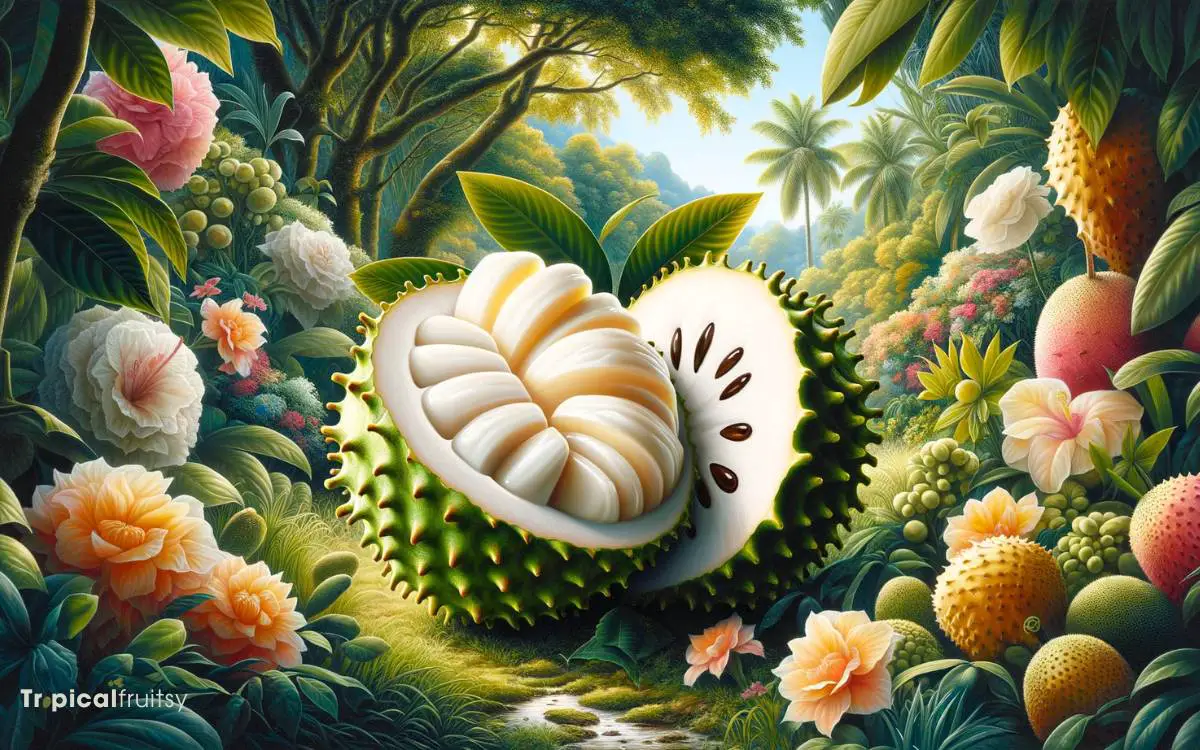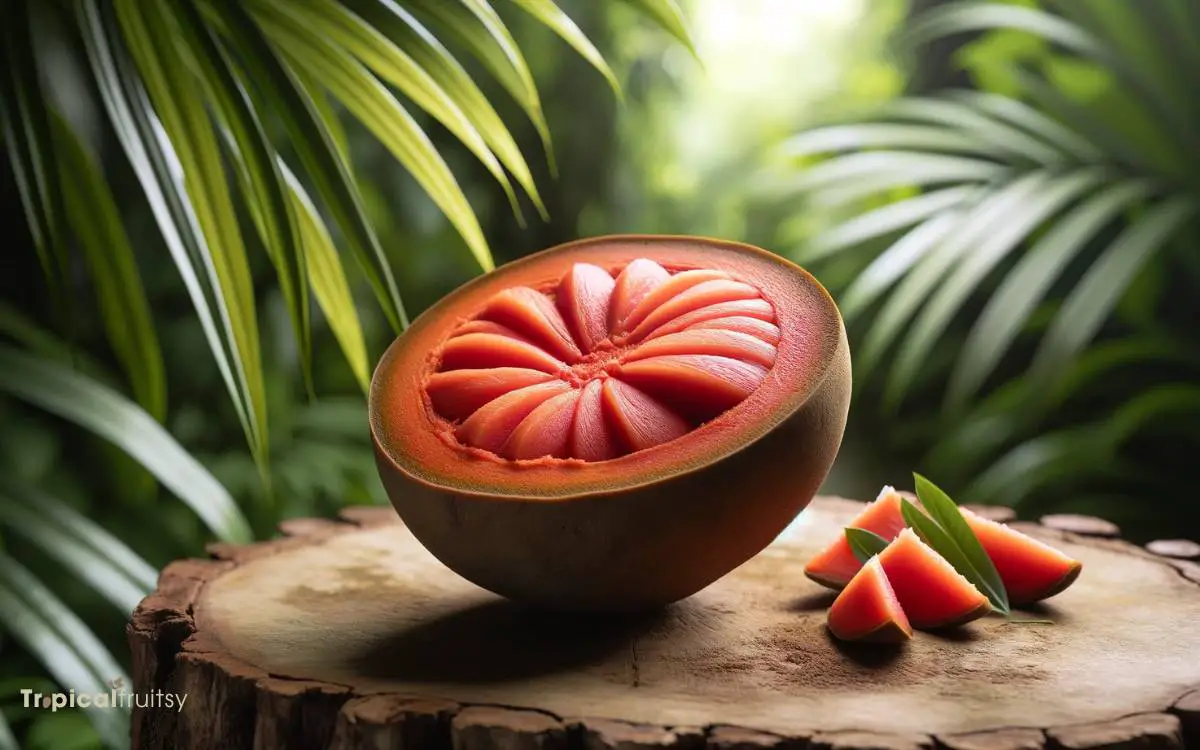Tropical Fruit That Tastes Like Ice Cream: Explore!
Discover the Exotic World of Tropical Fruits That Taste Like Ice. Cream Nature offers a variety of tropical fruits that boast flavors and textures akin to that of rich, creamy ice cream.
Among these are the cherimoya with its blend of banana, pineapple, and strawberry notes; the black sapote, known as the ‘chocolate pudding fruit’; and the lucuma, offering a caramel-like taste.
Fruits such as pawpaw, soursop, mamey sapote, and canistel also contribute to this unique category with flavors ranging from sweet custard to tangy citrus cream.
Tropical fruits have the remarkable ability to mimic dessert flavors which can provide a healthier alternative to traditional ice cream:
Other fruits such as the pawpaw and soursop deliver unique creamy tastes that can transform your perception of how a fruit can resemble beloved ice cream flavors.
Experience guilt-free indulgence with tropical fruits that deliver ice cream flavors in a natural, unprocessed form.

Key Takeaway
Exotic Fruits: Flavor Profiles, Textures, and Origins
| Fruit Name | Flavor Profile | Texture | Origin |
|---|---|---|---|
| Cherimoya | Banana, pineapple, strawberry | Velvety, custard | Andes |
| Black Sapote | Chocolatey | Pudding-like | Eastern Mexico, Caribbean |
| Lucuma | Caramel-like | Smooth | Andean valleys of Peru |
| Pawpaw | Banana-like custard | Creamy | Eastern United States |
| Soursop | Citrus cream blend | Creamy, fibrous | Tropical Americas |
| Mamey Sapote | Earthy sweetness with hints of pumpkin and cherry | Velvety | Central America |
| Canistel | Sweet, pumpkin pie-like | Moist, custard | Southern Mexico to Brazil |
Cherimoya: Nature’s Custard

The cherimoya’s creamy texture and sweet flavor have earned it the nickname ‘Nature’s Custard,’ appealing to those who crave a dessert-like fruit.
Botanically known as Annona cherimola, this subtropical species thrives in high-altitude regions with temperate climates.
Its unique organoleptic properties derive from a rich blend of volatile compounds, including ethyl butanoate and hexyl acetate, which contribute to its distinctive aroma and sugary taste profile.
The flesh’s high sugar content, predominantly fructose, and the presence of annonaceous acetogenins render the cherimoya both a natural sweet treat and a subject of pharmacological interest.
Despite its luscious appeal, the fruit’s cultivation and post-harvest handling require meticulous care to avoid bruising and to ensure optimal ripeness, factors that are critical to maintaining its delicate flavor composition.
Black Sapote’s Chocolate Pudding

Renowned for its rich, custard-like texture and flavor reminiscent of chocolate pudding, the black sapote is a tropical fruit treasured by enthusiasts for its dessert-like qualities.
An analytical dissection of this fruit’s attributes reveals:
- Diospyros digyna: The botanical nomenclature, placing it within the persimmon family.
- Ripening Process: The transformation to a chocolate pudding consistency occurs post-harvest, as the fruit softens.
- Nutritional Profile: Rich in vitamins C and A, calcium, and potassium, with low fat content.
- Culinary Versatility: Utilized in various recipes from smoothies to cakes, enhancing dishes without artificial flavors.
The black sapote’s appeal lies not just in its sweet, mellow flavor but also in its adaptability within gastronomy and its contribution to nutritional intake, making it a prized ingredient in health-conscious culinary circles.
Lucuma: The Gold of the Incas

Lucuma, often heralded as the ‘Gold of the Incas,’ is a fruit indigenous to the Andean region of South America, revered not only for its rich, maple-like flavor but also for its substantial nutritional profile.
As a source of carbohydrates, fiber, vitamins, and minerals, its incorporation into diets offers potential benefits such as improved blood sugar control and a lowered risk of chronic disease.
The versatility of lucuma extends to its culinary applications, where it is frequently processed into powder form and used as a natural sweetener and flavor enhancer in desserts, lending a subtle sweetness without a significant spike in glucose levels.
Nutritional Benefits
Amidst its delightful flavor profile, lucuma offers a wealth of nutritional benefits, earning its historical title as ‘The Gold of the Incas’.
This sweet subtropical fruit is not only valued for its unique taste that resembles a cross between maple and sweet potato but also for its dense nutrient composition.
Here are some of the key nutritional attributes of lucuma:
- Fiber Content: Lucuma is rich in dietary fiber, which aids in maintaining digestive health and regulating blood sugar levels.
- Antioxidants: The fruit contains a variety of antioxidants, including carotenoids and vitamin C, which combat oxidative stress and bolster the immune system.
- Minerals: It is a good source of minerals such as potassium, calcium, and phosphorus, which are essential for bone health, cardiovascular function, and cellular operations.
- Low Glycemic Index: Lucuma has a low glycemic index, making it a favorable option for those managing their glycemic load.
Culinary Uses
Beyond its nutritional virtues, lucuma is highly versatile in the kitchen, often incorporated into desserts and sweet treats due to its creamy texture and naturally sweet flavor.
This subtropical fruit, revered since the Inca civilization, has found its way into modern gastronomy.
Lucuma powder, derived from the dehydrated fruit, is extensively utilized as a natural sweetening agent, offering a low-glycemic alternative to refined sugars.
Its application spans from enriching smoothies and milkshakes to flavoring ice cream, where it imparts a caramel-like essence.
Pastry chefs value lucuma for its ability to integrate seamlessly into batters, custards, and fillings, enhancing the complexity of their creations without overpowering them.
This delicate balance sets the stage for exploring another tropical contender, the bananalike pawpaw, which offers its own rendition of perfection.
Bananalike Pawpaw Perfection

The pawpaw, a lesser-known tropical fruit, offers a creamy, custard-like flavor reminiscent of banana and is often hailed for its ice cream-like qualities.
This unique fruit exhibits several distinctive characteristics:
- Asimina triloba: The pawpaw’s scientific designation, indicating its genus and species within the Annonaceae family.
- Nutrient Composition: Rich in vitamins C and A, riboflavin, and antioxidants, contributing to its healthful profile.
- Climacteric Ripening: The pawpaw undergoes a post-harvest ripening process, which enhances its sweetness and soft texture.
- Limited Shelf Life: Due to rapid ripening, pawpaws have a shorter shelf life, necessitating prompt consumption or processing after harvest.
Analyzing the pawpaw’s composition and post-harvest behavior underlines its potential in culinary applications, yet also highlights the challenges in commercial distribution and storage.
Soursop’s Creamy Citrus Blend

Within the realm of tropical fruits, the soursop stands out for its velvety texture and distinctive flavor that fuses notes of citrus with the richness of cream.
Scientifically referred to as Annona muricata, this fruit’s pulp is characterized by an aromatic profile that is both complex and nuanced.
The soursop’s flavor profile is underpinned by a balance of sweet and tart taste elements, which culminates in a creamy, custard-like consistency upon consumption.
The intricacies of soursop’s flavor are attributed to its diverse range of volatile compounds, including esters, alcohols, and ketones, which contribute to its citrusy undertones.
These organoleptic properties make soursop a versatile ingredient in culinary applications, ranging from beverages to desserts, where it imparts a lush mouthfeel and a sophisticated, tangy twist.
Mamey Sapote’s Sweet Earthiness

The Mamey Sapote, a lesser-known tropical fruit, offers a complex flavor profile that distinguishes it within the culinary world.
Its sweet, earthy taste with nuances of almond, chocolate, and honey makes it a versatile ingredient for innovative dessert creations.
The fruit’s dense, creamy texture further contributes to its suitability as a natural base for ice cream and other confectioneries, warranting a detailed examination of its application in dessert gastronomy.
Flavor Profile Complexity
Mamey sapote’s rich flavor profile features a unique blend of sweet, earthy notes reminiscent of a creamy dessert.
The complexity of its taste derives from a sophisticated amalgamation of sensory compounds that engage the palate in a multifaceted experience.
To dissect this complexity, consider the following components:
- Natural sugars: Predominantly fructose, contributing to the fruit’s inherent sweetness.
- Volatile compounds: Subtle aromatic elements that provide a nuanced bouquet.
- Carotenoids: Imparting a slight carrot-like earthiness alongside vibrant color.
- Texture influencers: The creamy, avocado-like consistency augments the perception of richness in flavor.
Each element plays a critical role in the overall sensory profile, with the interplay of sweetness, aroma, and mouthfeel distinguishing Mamey sapote as a fruit of exceptional flavor depth.
Unique Dessert Ingredient
Building on its intriguing flavor palette, mamey sapote’s sweet earthiness makes it an exceptional addition to desserts, offering a natural ice cream-like taste that chefs and food enthusiasts covet.
Its rich texture and unique flavor profile enable it to stand out in a variety of culinary applications, especially within confectionery contexts.
The fruit’s inherent sweetness and smooth consistency serve as a robust foundation for complex flavor harmonies when paired with other ingredients.
| Dessert Application | Complementary Flavors |
|---|---|
| Ice Cream Base | Cinnamon, Nutmeg |
| Sorbet | Lime, Ginger |
| Mousse | Almond, Vanilla |
| Pudding | Coconut, Caramel |
| Cake Filling | Chocolate, Hazelnut |
When utilized in desserts, mamey sapote imparts a nuanced sweetness, accompanied by a velvety texture that enhances the overall sensory experience.
Its integration into dessert recipes not only introduces a novel flavor but also amplifies the dish’s aromatic profile and richness.
Is the Tropical Fruit Flavor of Pepcid Complete Safe to Consume?
Yes, Pepcid Complete Tropical Fruit Flavor is safe to consume. The tropical fruit flavor makes it enjoyable to take, and the combination of active ingredients effectively relieves heartburn and acid indigestion. Many people find it convenient and effective for managing these symptoms.
Canistel: The Eggfruit Dessert

Amidst the array of tropical fruits with dessert-like qualities, canistel, commonly referred to as eggfruit, stands out for its naturally sweet flavor and custard-like texture.
This fruit’s delectable characteristics make it an ideal ingredient for a variety of desserts and confections.
In analyzing the canistel, several key attributes warrant consideration:
- Nutritional Content: Rich in vitamins A and C, dietary fiber, and antioxidants.
- Culinary Versatility: Easily integrated into smoothies, pies, and custards.
- Texture Analysis: Firm when young, but develops a creamy, pudding-like consistency when ripe.
- Flavor Profile: Subtle sweetness with hints of pumpkin or sweet potato, complementing spices like nutmeg and cinnamon.
Understanding these aspects of canistel allows culinary professionals to craft desserts that harness its unique qualities, resulting in innovative dishes that intrigue the palate.
Conclusion
In the realm of exotic flora, the aforementioned fruits serve as nature’s confectionery, with each offering a unique fusion of flavors that mimic indulgent desserts.
It is as if Mother Nature, in her unending creativity, has concocted a veritable smorgasbord of creamy delights, designed to satiate the palate without the need for artificial sweetness.
These tropical treasures are not only gustatory marvels but also exemplify the intricate interplay of natural sugars and textures in the plant kingdom.






